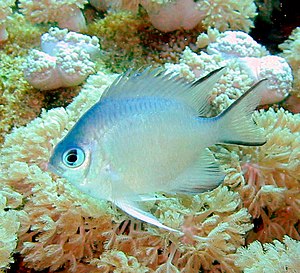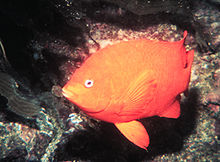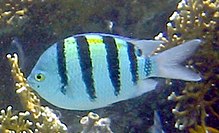Damselfish
| Damselfish | ||||||||||||
|---|---|---|---|---|---|---|---|---|---|---|---|---|

Amblyglyphidodon indicus |
||||||||||||
| Systematics | ||||||||||||
|
||||||||||||
| Scientific name | ||||||||||||
| Pomacentridae | ||||||||||||
| Bonaparte , 1832 | ||||||||||||
The damselfish (Pomacentridae), which are also called juvenile fish or coral perch in German , are marine fish from the group of perch relatives (Percomorphaceae) that live near the coast . The most famous damselfish include the anemonefish ( Amphiprion ), which live in a symbiosis with large sea anemones .
Carl von Linné , the founder of the biological classification system , described three damselfish ( Abudefduf saxatilis , Amphiprion polymnus and Dascyllus aruanus ) using binomial nomenclature as early as 1758 .
distribution
Damselfish live in the tropical and subtropical zones of all oceans, always on the coasts of rock and coral reefs . One species, the monk fish ( Chromis chromis ), also lives in the Mediterranean and Black Seas . As a result of Lesseps' migration through the Suez Canal , Abudefduf saxatilis has also migrated to the Mediterranean. Two species, Neopomacentrus taeniurus in the western Indo-Pacific and Stegastes otophorus in the Caribbean , occur in the brackish water of estuaries and in coastal fresh water. The species of the Indo-Australian genus Dischistodus live mainly on sandy and muddy floors in sheltered bays and cloudy water.
features
Damselfish are small, stocky, more or less high-backed fish that are four to 35 centimeters long. The body is covered with ctenoid scales. Their mouths are small and have conical teeth, which often have brush-like tips. The lower maw teeth have grown together. Damselfish have a single continuous dorsal fin with 8 to 17 hard and 11 to 18 soft rays . The front, hard-rayed part is longer than the soft-rayed part of all species. The anal fin has two, rarely three hard rays. The lateral line organ is incomplete and ends under the soft rayed part of the dorsal fin. Unlike most other fish, damselfish have only one pair of nostrils that are blind. Most other fish, including perch, have two pairs of continuous nasal passages. Many species of damselfish that live in tropical waters are brightly colored, with their backs and belly often different. Vertical stripes are also found in many genera. The juveniles of many species have a much more splendid color dress than the adults .
The largest damselfish is the bright orange colored Garibaldi fish ( Hypsyops rubicundus ), which lives in the cool waters of the kelp forests on the California coast.
nutrition
Most are zooplankton eaters (genera Abudefduf , Chromis and Dascyllus ), other omnivores or algae eaters , such as the genus Parma . The Stegastes TYPES place as a farmer fish seaweed beds on dead hard coral branches to defend these and pluck unpalatable algae so that thrive better tasting.
Reproduction
All damselfish do brood care. They spawn on solid substrates , either open or in caves. The males or pair guard and care for the eggs until the larvae hatch. The swallowtail damselfish ( Acanthochromis polyacanthus ) and the three species of the genus Altrichthys are the only ones to protect the young for up to 4 weeks after hatching.
External systematics and tribal history
The damselfish are often placed in the subordination of the wrasse-like (Labroidei). The relationship of the families is supported by the anatomy of the pharynx and gill region. However, DNA sequencing does not reveal any relationship between wrasse , parrot fish and odacids on the one hand and cichlids , surf bass and damselfish on the other. The similar skull anatomy must have arisen twice independently of each other.
A new systematic group within the perch relatives, the ovalentaria , is therefore proposed for damselfish, surf perch and cichlid and some other taxa related to them . The closest relatives and thus the sister group of damselfish are the miracle perches (Plesiopidae).
With Odonteus pygmaeus from the Monte Bolca Formation, they can be proven in fossil form since the middle Eocene .
Internal system
According to Cooper, Smith & Westneat (2009) the damselfish are divided into five subfamilies. At the base are the Stegastinae , a clade of seven, sometimes quite large, also herbivorous species that live in temperate waters, as a sister group to all other damselfish . This is followed by the elongated fusilier damselfish ( Lepidozygus tapeinosoma ) monotypically in the subfamily Lepidozyginae. The Chrominae , which contained five genera in an older classification by Gerald R. Allen , now only consist of the genera Chromis and Dascyllus . Chromis is not monophyletic as Dascyllus is part of the Chromis clade. All chrominae are small, predominantly tropical, reef-dwelling, school-forming and plankton-eating damselfish that live in a very close, sometimes commensal relationship with stony corals . The genus Abudefduf is monophyletic and is the only one of the subfamily Abudefdefinae. All other damselfish are placed in the subfamily Pomacentrinae , including the anemonefish , a group of 27 species, some of which are very closely related, which perhaps only recently split up into the species that exist today. They do not have such a prominent position that they can form their own subfamily as they do with all of them. The two genera of the anemonefish, Amphiprion and Premnas , are united in the tribe Amphiprionini.
There are 29 genera with almost 400 species .

-
Stegastinae Cooper, Smith, Westneat, 2009
- Hypsypops Gill, 1861
- Mecaenichthys Whitley, 1929
- Microspathodon Günther, 1862
- Nexilosus Heller & Snodgrass, 1903
- Parma Günther, 1862
- Plectroglyphidodon Fowler & Ball, 1924
- Similiparma Hensley, 1986
- Stegastes Jenyns, 1840
- Lepidozyginae
- Lepidozygus Günther, 1862
-
Chrominae
- Azurina Jordan & McGregor, 1898
- Chromis Cuvier, 1814
- Prussian fish ( Dascyllus ) Cuvier, 1829
- Abudefdufinae Cooper, Smith, Westneat, 2009
- Abudefduf Forsskål, 1775
-
Pomacentrinae
- Acanthochromis Gill, 1863
- Altrichthys Allen, 1999
- Amblyglyphidodon Bleeker, 1877
- Amblypomacentrus Bleeker, 1877
- Cheiloprion Weber, 1913
- Chrysiptera Swainson, 1839
- Dischistodus Gill, 1863
- Hemiglyphidodon Bleeker, 1877
- Neoglyphidodon Allen, 1991
- Neopomacentrus Allen, 1975
- Pomacentrus Lacepède, 1802
- Pomachromis Allen & Randall, 1974
- Pristotis Rüppell, 1838
- Teixeirichthys Smith, 1953
-
Anemonefish (Amphiprionini)
- Amphiprion Bloch & Schneider, 1801
- Premnas
The following cladogram shows the probable relationships between the subfamilies:
| Damselfish |
|
||||||||||||||||||||||||
|
|
Aquarium keeping
Damselfish are an important family of fish for saltwater aquariums , as in most cases they are not too difficult to maintain, even for beginners. Only their aggressiveness often causes problems. This is especially true for the three-point Prussian fish ( Dascyllus trimaculatus ) that is often offered . Other species, especially members of the genera Microspathodon and Neoglyphodon , are only attractively colored when they are young and, as adult fish, acquire a uniformly simple color.
In addition to the anemonefish, the following species are particularly suitable as aquarium fish because of their beautiful colors and relatively low tendency to aggression:

- Black- axed swallowtail ( Chromis atripectoralis )
- Blue swallowtail ( Chromis cyanea )
- Black banded swallowtail ( Chromis retrofasciata )
- Green swallowtail ( Chromis viridis )
- Azure Demoiselle ( Crysiptera hemicyanea )
- Talbot's Demoiselle ( Crysiptera talboti )
- Yellowtail Demoiselle ( Crysiptera parasema )
- Red Sea Prussian Fish ( Dascyllus marginatus )
- Four-banded Prussian fish ( Dascyllus melanurus )
- Yellow-bellied Demoiselle ( Pomacentrus auriventris )
- Neon Demoiselle ( Pomacentrus coelestris )
Sources and further information
Sources cited
Most of the information in this article is taken from the sources given under literature, and the following sources are also cited:
- ↑ CIESM Atlas of Exotic Fishes in the Mediterranean
- ^ Joseph S. Nelson : Fishes of the World , John Wiley & Sons, 2006, ISBN 0-471-25031-7
- ↑ Kurt Fiedler: Textbook of Special Zoology, Volume II, Part 2: Fish , Gustav Fischer Verlag Jena, 1991, ISBN 3-334-00339-6
- ↑ Ellen Thaler : Sea fish with real brood care: Swallowtail damselfish , in DATZ , 9/98
- ↑ Bernardi G (2011) Monophyletic origin of brood care in damselfishes. Molecular Phylogenetics and Evolution 59: 245-8. doi: 10.1016 / j.ympev.2010.12.021
- ↑ Mabuchi, Miya, Azuma & Nishida: Independent evolution of the specialized pharyngeal jaw apparatus in cichlid and labrid fishes. BMC Evolutionary Biology 2007, 7:10 doi: 10.1186 / 1471-2148-7-10
- ↑ Peter C. Wainwright, W. Leo Smith, Samantha A. Price, Kevin L. Tang, John S. Sparks, Lara A. Ferry, Kristen L. Kuhn, Ron I. Eytan & Thomas J. Near: The Evolution of Pharyngognathy : A Phylogenetic and Functional Appraisal of the Pharyngeal Jaw Key Innovation in Labroid fishes and Beyond. Syst Biol (2012) doi: 10.1093 / sysbio / sys060
- ↑ Ricardo Betancur-R., Richard E. Broughton, Edward O. Wiley, Kent Carpenter, J. Andrés López, Chenhong Li, Nancy I. Holcroft, Dahiana Arcila, Millicent Sanciangco, James C Cureton II, Feifei Zhang, Thaddaeus Buser, Matthew A. Campbell, Jesus A Ballesteros, Adela Roa-Varon, Stuart Willis, W. Calvin Borden, Thaine Rowley, Paulette C. Reneau, Daniel J. Hough, Guoqing Lu, Terry Grande, Gloria Arratia, Guillermo Ortí: The Tree of Life and a New Classification of Bony Fishes. PLOS Currents Tree of Life. 2013 Apr 18. Edition 1. doi: 10.1371 / currents.tol.53ba26640df0ccaee75bb165c8c26288 , PDF ( Memento of the original from October 13, 2013 in the Internet Archive ) Info: The archive link was inserted automatically and has not yet been checked. Please check the original and archive link according to the instructions and then remove this notice.
- ^ Karl Albert Frickhinger: Fossil Atlas Fish , Mergus-Verlag, Melle, 1999, ISBN 3-88244-018-X
- ^ A b Cooper, Smith, Westneat: Exploring the radiation of a diverse reef fish family: Phylogenetics of the damselfishes (Pomacentridae), with new classifications based on molecular analyzes of all genera. Molecular Phylogenetics and Evolution, Volume 52, Issue 1, July 2009, Pages 1-16, doi: 10.1016 / j.ympev.2008.12.010
literature
- Gerald R. Allen : Damselfish of the World , Mergus Verlag Melle, 1991, ISBN 3-88244-007-4
- KORALLE, marine aquaristic specialist magazine, No. 40 August / September 2006, Natur und Tier Verlag Münster, ISSN 1439-779X
Web links
- Damselfish on Fishbase.org (English)
- Damselfish on the Animal Diversity Web





